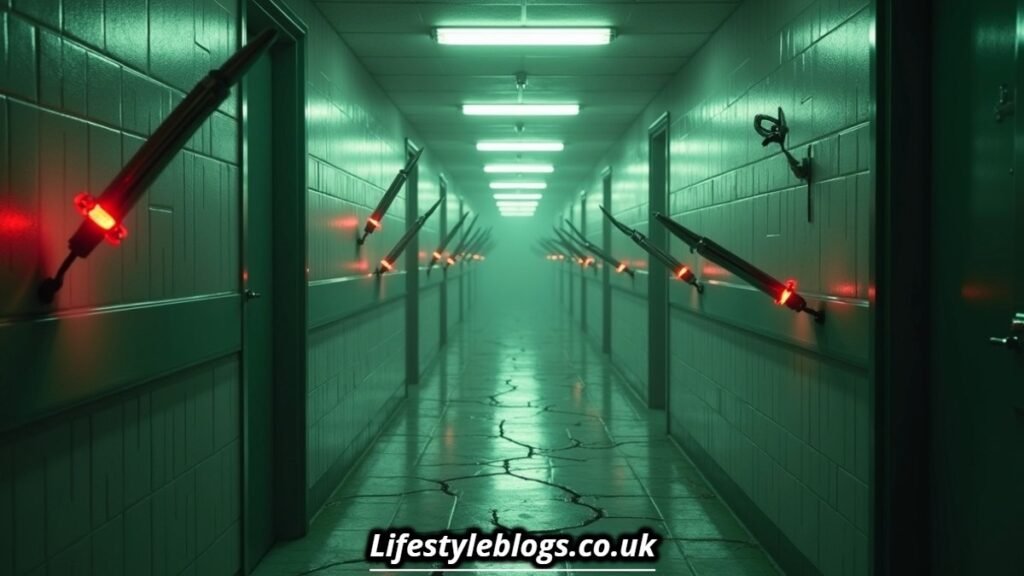In horror art, AI-generated images are revolutionizing the genre, introducing chilling new themes that unsettle, fascinate, and provoke reflection. Among these, needle imagery—with its sharp associations of pain, vulnerability, and medical intervention—stands out as particularly haunting. This article explores the unsettling appeal of AI art in horror, diving into its psychological impact, artistic innovations, cultural roots, and ethical dilemmas.
The Psychological Impact of Needle Imagery
Needles tap into a universal human anxiety. The medical setting already carries associations of illness, fragility, and loss of autonomy. When AI art depicts needles as exaggerated, dystopian instruments resembling tools of torture, it amplifies feelings of discomfort, helplessness, and invasion of the body. This connects directly with trypanophobia (fear of injections) and broader fears of medical vulnerability, transforming the ordinary into something terrifying.
But there’s more: these visuals also create space for catharsis—a safe environment where audiences confront their fears without real danger. By doing so, horror provides not only dread but also a strange form of enjoyment, allowing people to symbolically master what unsettles them most.
Fear and Fascination: The Duality of Horror
Horror has always lived in paradox: it terrifies while it fascinates. AI-generated horror art with needles perfectly embodies this duality. On one side, the imagery evokes dread, helplessness, and even trauma; on the other, it captivates with its surreal beauty, intricate textures, and thought-provoking symbolism. This balance between attraction and repulsion is what keeps audiences engaged, ensuring horror remains a powerful artistic force.
Historical Roots of Horror Imagery
To understand AI horror today, we must acknowledge its past. From ancient civilizations that used ritual masks, blood sacrifice, and mythology to invoke fear, to folklore filled with supernatural entities and grotesque beings, horror has always mirrored human anxieties. Early cinema amplified this tradition, shaping classic tropes of monsters, shadows, and dread. AI horror continues this lineage, remixing myth, literature, and film history into futuristic, digital reinterpretations.
Technology, AI, and Creative Innovation
The transformative shift brought by artificial intelligence has redefined horror aesthetics. With tools like Generative Adversarial Networks (GANs), neural algorithms, Stable Diffusion, and MidJourney, machines can analyze vast datasets of horror tropes and generate imagery that feels both familiar and alien.
Artists like Mario Klingemann and Refik Anadol pioneered immersive, data-driven installations that merge unsettling themes with abstract beauty. Their works, alongside emerging AI creators, demonstrate how software techniques, surreal textures, and uncanny compositions produce intricately detailed, emotionally impactful horror art.
Aesthetics: Color, Light, and Composition in AI Horror
Needle horror art uses color, tone, and structure deliberately.
- Dark hues, sharp contrasts, eerie greens, and deep reds symbolize sickness and blood.
- Light and shadow interact to guide the viewer’s eye, creating foreboding atmospheres.
- Composition emphasizes invasion, control, and bodily vulnerability, often positioning needles as dominating, central symbols.
This interplay of aesthetic beauty and disturbing imagery reflects the essence of horror: the beautiful made terrifying.
Viewer Engagement and Cultural Conversations
AI horror art does more than frighten—it engages audiences in conversation. These works often spark discussions about human vulnerability, control, mortality, and the ethics of artificial creativity. Viewers are not passive; they reflect, interpret, and sometimes debate the meaning of these images, transforming horror into a shared cultural dialogue.
Ethical Considerations in AI Horror
As AI grows more sophisticated, its ability to disturb, frighten, or even traumatize raises ethical concerns. Should there be limits on depicting invasive medical horror? Where does freedom of expression end and harm begin? Horror thrives on discomfort, but balance is essential. Artists must navigate this tension responsibly while still pushing creative boundaries.
The Future: Personalization, VR, and Emerging Subgenres
AI horror continues to evolve, offering rich possibilities:
- Personalized fear experiences, where algorithms adapt to individual anxieties.
- VR (Virtual Reality) and AR (Augmented Reality) environments, allowing users to step directly into immersive horror worlds.
- New subgenres blending cyberpunk, medical horror, body horror, and surrealism.
In the coming years, AI horror will not only terrify but also deepen emotional engagement, offering audiences interactive, adaptive, and highly personalized experiences.
Conclusion
AI-generated horror art with needles symbolizes a fascinating convergence of technology, psychology, and culture. It terrifies, fascinates, and provokes thought—continuing horror’s long tradition while reshaping its future. By blending ancient fears with modern algorithms, AI horror reflects both our deepest anxieties and our endless curiosity about the unknown.
FAQs
What is AI horror art?
AI horror art refers to images or installations created with artificial intelligence tools (like GANs, MidJourney, or Stable Diffusion) that explore dark, unsettling, or fear-based themes.
Why are needles such a popular symbol in AI horror?
Because they trigger deep-seated fears of pain, loss of control, and medical vulnerability (trypanophobia). AI magnifies these associations into surreal, terrifying visuals.
Is horror art meant only to frighten?
Not at all. Horror art also provides catharsis—a safe way to confront and release fear, often leaving viewers fascinated rather than traumatized.
How does AI change traditional horror art?
AI analyzes vast datasets of horror imagery, history, and tropes, then creates new, hybrid interpretations. This expands creativity, blending human imagination with machine precision.
What is the future of AI horror art?
Expect more personalized experiences, VR/AR immersion, and interactive storytelling, where fear adapts to each individual.
